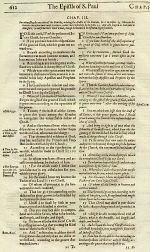
It doesn't take too much research into early English Bible versions to realize
that there was no love lost between Protestants and Roman Catholics during the 1500's. For centuries
the Catholic Church had based its beliefs on the Latin Vulgate version of the Bible and the
"tradition of the Fathers." Since very few English-speaking persons knew how to read Latin,
the Bible had to be translated and explained to them by the Catholic clergy. Protestants, on the other
hand, believed in the sole authority of the Scriptures (somtimes called "sola scriptura"), and felt that the Word of God should be translated into the
language used by everyday people and available to everyone. They felt that many corruptions had come into the Catholic Church
because so few people were able to read and understand the Bible for themselves.
In high religious circles, each side considered the other as enemies. The word "Protestant" had
yet to come into favor; Catholics simply called non-Catholics "heretics" — not a way to
make friends and break down barriers. So Catholics stuck to their Latin Bible, while Protestants kept on
producing new English-language versions.
Finally in the 1570's the Catholic Church realized that it was futile to continue to fight against the production of English-Language Bibles.
By then there had been six major versions of the Bible published by English-speaking Protestants. And even
a few devout Catholics risked excommunication by owning an English Bible for their personal reading. The
Pope finally softened his stance about "common language translations," and in 1582, from the College
of Rheims in France, an English Catholic New Testament was at last released. In 1609 it was joined
by the Old Testament. This Bible was called the "Rheims-Douay" Bible — the Catholic
Bible for English-speaking people. (You can
read about it and see actual pages in the "Early
Versions" section of our Web Site.)
Rather than cool the fires between Catholics and Protestants, this new Catholic version gave
Protestants even more material with which to confront the Roman Catholic Church. The Bible described
on this page was part of the continuing battle between English Protestants and the Church of Rome.
This dual-version New Testament Bible was printed in London in 1617 by Thomas Adams. In the left column (in standard
Roman typeface) are the text and marginal notes from the Rheims New Testament of 1582 — the Bible
authorized by the Catholic Church. In the right column (in italics) is the 1568 Bishops' Bible — used
by the Anglican Church and other Protestant sects. The differences in interpretation are evident as
you go through this Bible verse by verse. There was no question which side of the fence the publisher
was on. In this Bible's introduction, the Catholic version is said to have been made
"by the Papists of the traiterous Seminary at Rheims, pretending to
discover the corruptions of diverse translations and clear the controversy of these
days." The Protestant version was described as
the "noble translation ... used in the Church of England."
Click on the picture to the right for a close-up look.
This Bible also included what was called a "Confutation"
(See It) of the Catholic version by
the Protestant theologian William Fulke. Interestingly, if the purpose of this publication was to
destroy the Catholic version, it did not succeed. You see, this Bible -- sometime's called
"Faulke's Bible," gave publicity to the Rheims
translation that it would not have otherwise obtained. This page is a reminder of the unrelenting
religious hatred between Catholics and Protestants at that time. Be glad you didn't live in England back
then.
